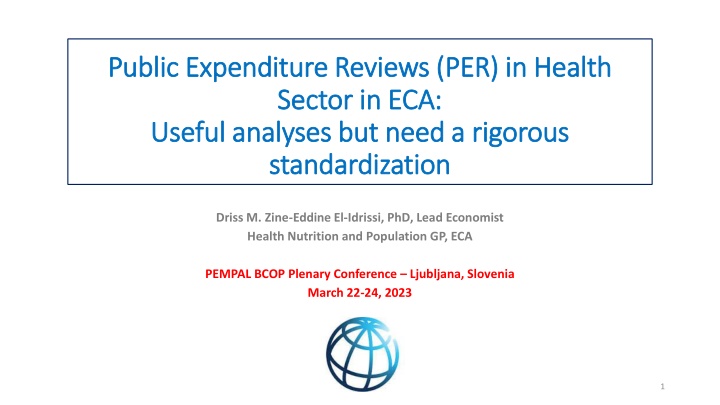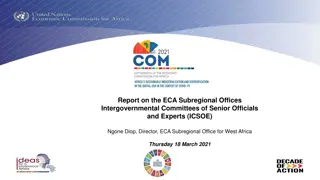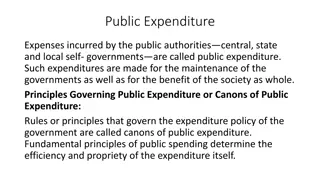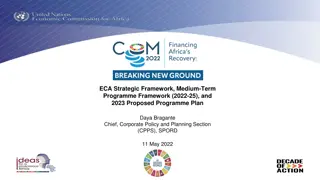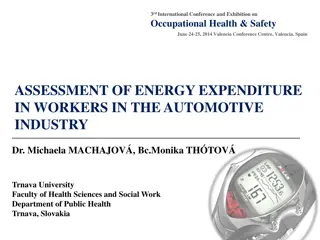Public Expenditure Reviews (PER) in Health Sector in ECA: An Overview
Public Expenditure Reviews (PER) in the health sector within the Europe and Central Asia (ECA) region focus on assessing public spending to improve efficiency, equity, and sustainability. PERs are vital for understanding the impact of government expenditures on poverty alleviation and public service delivery. These reviews delve into various aspects such as resource allocation, service distribution, efficiency, and budgeting processes, providing insights to enhance strategic planning and budget alignment. Rigorous standardization is needed to ensure the efficacy of PER analyses.
Download Presentation

Please find below an Image/Link to download the presentation.
The content on the website is provided AS IS for your information and personal use only. It may not be sold, licensed, or shared on other websites without obtaining consent from the author.If you encounter any issues during the download, it is possible that the publisher has removed the file from their server.
You are allowed to download the files provided on this website for personal or commercial use, subject to the condition that they are used lawfully. All files are the property of their respective owners.
The content on the website is provided AS IS for your information and personal use only. It may not be sold, licensed, or shared on other websites without obtaining consent from the author.
E N D
Presentation Transcript
Public Expenditure Reviews (PER) in Health Public Expenditure Reviews (PER) in Health Sector in Sector in ECA: Useful analyses but need a rigorous Useful analyses but need a rigorous standardization standardization ECA: Driss M. Zine-Eddine El-Idrissi, PhD, Lead Economist Health Nutrition and Population GP, ECA PEMPAL BCOP Plenary Conference Ljubljana, Slovenia March 22-24, 2023 1
PER and PER PER and PER- -Health (i/iii) Health (i/iii) PERs were developed to assess public spending, particularly in social sectors (health, education, social security ...), and to examine the effect of these expenditures on improving efficiency, equity and sustainability of funding in these sectors. Because of its interest in finance and public sectors for the economic justification of public expenditure, PERs have become an important technical tool to apprehend government capabilities and opportunities to fight effectively against poverty 2
PER and PER PER and PER- -Health (ii/iii) Health (ii/iii) They represent a set of analyzes of public institutions spending and resources. However, these analyzes are not concerned exclusively with financial aspects but incorporate other dimensions that allow them to explore areas of interest such as efficiency and equity... 3
PER and PER PER and PER- -Health (iii/iii) Health (iii/iii) In health sectors, PERs try to answer questions such as: How are public spending and services distributed among the population? Are public interventions efficient? What is the impact of public spending on equity? What are budgetary process and public expenditure execution bottlenecks? Are strategic planning and budgeting aligned? 4
PER PER- -Health prepared for ECA countries Health prepared for ECA countries During the last 5 years, PERs-Health (stand alone report or a chapter dedicated to health in a multisectoral document) have been prepared for: Armenia Belarus Croatia Georgia Kyrgyzstan Kosovo North Macedonia Romania Tajikistan Ukraine Uzbekistan 5
PER PER- -Health in ECA countries: Scope of work Health in ECA countries: Scope of work Magnitude of health resources Inefficiencies (technical and allocative) of public spending with overemphasis on hospitals Human Resources / Civil Servants status Pharmaceuticals Social Health Insurance Purchasing / Strategic Purchasing Equity and Financial Protection Decentralization 6
PER PER- -Health in ECA countries: Challenges and Health in ECA countries: Challenges and constraints constraints In general, access to information is not difficult but challenging in a few countries Lack of data on: Quality of care indicators Facility outputs/productivity Pharmaceuticals Quality of data / Modest health information system /data not updated Definition of public expenditure (Commitments Vs Verification Vs Payment Authorization Vs Payments). 7
PER PER- -Health and policy dialogue in ECA countries Health and policy dialogue in ECA countries (i/ii) (i/ii) PER-Health as a chapter in a broader PER (with other Sectors) has advantages: Setting health in a bigger context Our colleagues in other Units (MTI, Governance ) are more aware of health issues Information in combined PER is very concise and therefore more useful to Ministry Of Finance / Planning / Economy which kept updated and interested in health expenditures and outcomes. 8
PER PER- -Health and policy dialogue in ECA countries Health and policy dialogue in ECA countries (ii/ii) (ii/ii) Role in the policy dialogue: Detecting additional studies required for evidence-based health policies Providing technical advice on PFM issues in the health sector Providing advice on (important) health system reforms Identifying areas of WB s support / interventions to help countries advance the Universal Health Coverage Agenda. 9
Are PERs Are PERs- -Health similar to Health Accounts (SHA 2011)? Health similar to Health Accounts (SHA 2011)? Some similarities but not the same objective and methodology Some similarities but not the same objective and methodology SHA (System of Health Accounts) is a widely used and globally recognized framework to track the flow of funds across the health system, whether public, private, or external. SHA provides information not only on the sources of funding but also on the purposes of funding. (World Bank) Health Accounts provide a systematic description of the financial flows related consumption of health care goods and services. Their intent is to describe a health system from an expenditure perspective. (OECD, EUROSTAT, WHO) to the 10
Main HAs Indicators Main HAs Indicators Total current health expenditure (THE) Total expenditure on medicines Total expenditure on outpatient care Share of THE from GDP Share of public expenditure on health from THE Share of out-of-pocket expenditure from THE Share of Donors expenditure from THE Share of medicine from THE Per-capita THE Per-capita expenditure on inpatient care Per-capita expenditure on medicine [Using current / constant prices; Local currency / US$; Current Exchange Rate / PPP] These indicators are included in WHO and WB databases 11
Are PER Are PER- -Health and HAs harmonized (i/v)? Health and HAs harmonized (i/v)? Crossing PERs and HAs Crossing PERs and HAs Public Expenditure Reviews Public expenditure on Education Public expenditure on Agriculture HAs Private expenditure on Health Public expenditure on Health Rest of the World (external funds) expenditure on Health Public expenditure on Justice Other Public expenditure 12
Are PER Are PER- -Health and HAs harmonized (ii/v)? Health and HAs harmonized (ii/v)? PER-Health (PER-H) and HAs are complementary tools They are mutually useful However, their respective natures are different: HAs are standardized accounts underpinned by T-accounts logic. They pertain to the whole health system PER-Hs are not standardized. They are in form of analyzes using several tools and techniques such as HAs, audits, benefit incidence analysis, cost-effectiveness analysis, Public Expenditure Tracking Surveys (PETS) ... 13
Are PER Are PER- -Health and HAs harmonized (iii/v)? Health and HAs harmonized (iii/v)? PER-Hs review public policies in the area of resources mobilization, spending and distribution of these resources. They also examine institutional aspects pertaining to public expenditure and can go beyond health sector. They are not based on methodological orthodox requirements or international classifications & predetermined standards, although there are guides. PER: https://openknowledge.worldbank.org/handle/10986/2109 PER-Human Development: http://web.worldbank.org/archive/website01397/WEB/0__CONTE.HTM PER-Health: http://web.worldbank.org/archive/website01397/WEB/0__CONTE.HTM 14
Are PER Are PER- -Health and HAs harmonized (iv/v)? Health and HAs harmonized (iv/v)? In several countries where PER-Hs and HAs have been conducted simultaneously, health financing system analysis has been pretty well done. However: differences in public expenditure figures have been evident (ex. treatment of out-of pocket in public facilities and Internally Generated funds by Public Facilities); dual exercise has been too burdensome, lengthy & costly; the analysis has not been always complete because HAs did not go beyond the accounting logic and PER-Hs have been related only and logically to the public sector. 15
Are PER Are PER- -Health and HAs harmonized (v/v)? Health and HAs harmonized (v/v)? Sectors and Health Financing review tools Accounts or equivalent Analyses / Reviews Non covered without (parallel) analyses SHA (standard) Private sector Deep financial analysis of the health system Public sector Covered by PERs-Health or SHA parallel analyses SHA (standard) + PER- Health (non-standardized) 16
Why they should be harmonized? Why they should be harmonized? Although we tend to consider PER-H and HAs as complementary tools and slightly redundant, in fact, for the public sector, they seek and use almost same information and data. Therefore, optimizing the use of effort, time and resources would be required Harmonization could easily avoid, or at least mitigate, redundancies and even potential contradictions. Which would give more credibility to both tools and allow them to be more efficient and more useful to decision makers. 17
PER PER- -Hs standardized (i/ii) Hs standardized (i/ii) Similar to HAs, the PER-Hs must standardize expenditure classifications, but also resources / sources of funds and types of public institutions PER-Hs should use, as far as possible, same standards as the Government Finance Statistics (IMF), the System of National Accounts (UN) and SHA classifications in terms of Health Care Functions , Health Care Providers , Health Care Financing Schemes , 18
PER PER- -Hs standardized (ii/ii) Hs standardized (ii/ii) Standardization is important because it will achieve the following objectives: It will bring more technical rigor and strengthen PER-H methodological approach in defining clearly institutions categories, resources & expenditure, but also their boundaries It will make easier to undertake robust comparative analyzes over time within the same country and good comparability between countries Methodological rigor and standardization will help to improve quality of PER-H analyses and results 19
Thank you 20
